Multicase Study Comparison of Different Types of Flood-Resilient Buildings (Elevated, Amphibious, and Floating) at the Vistula River in Warsaw, Poland
Abstract
:1. Introduction
1.1. The Relationships of Risk, Vulnerability, and Resilience
1.2. Floods in Europe
1.3. Flood Resilient Strategies
1.4. Research Purpose
2. Materials and Methods
3. The Research Context
3.1. The Vistula River in Warsaw
3.2. Floods and Drouths
3.3. Building Restrictions
4. Multiple-Case Study
4.1. Beach Pavilion
4.2. Amphibious Boulevard Pavilions
4.3. Water Tram Terminals
5. Results—Comparison of Different Amphibious Techniques
5.1. Flood Resilience
5.2. Relation to Water vs. Relation to Land
5.3. Design Considerations
6. Discussion
7. Conclusions
Author Contributions
Funding
Acknowledgments
Conflicts of Interest
References
- Outreville, J.F. The Meaning of Risk. In Theory and Practice of Insurance; Springer: Boston, MA, USA, 1998; pp. 1–12. [Google Scholar] [CrossRef]
- Berg-Beckhoff, G.; Wiedemann, P.; Ádám, B.; Schüz, J.; Breum Ølgaard, K.; Tanggaard Andersen, P.; Ndugwa Kabwama, S.; Nielsen, J. Risk Definitions—Risk Research Is Done in Multiple Disciplines; but Is It Multidisciplinary? Eur. J. Public Health 2015, 25 (Suppl. 3). [Google Scholar] [CrossRef]
- Albris, K.; Lauta, K.C.; Raju, E. Disaster Knowledge Gaps: Exploring the Interface between Science and Policy for Disaster Risk Reduction in Europe. Int. J. Disaster Risk Sci. 2020, 11, 1–12. [Google Scholar] [CrossRef] [Green Version]
- Kelman, I. Lost for Words amongst Disaster Risk Science Vocabulary? Int. J. Disaster Risk Sci. 2018, 9, 281–291. [Google Scholar] [CrossRef] [Green Version]
- Contreras, M.E.M. Ian Burton, W. Kates y Gilbert F. White. The environment as hazard. Nueva York: Oxford University Press, 1978. 240p. Estud. Demogr. Urbanos 1986, 1, 317. [Google Scholar] [CrossRef] [Green Version]
- Hewitt, K. Regions of Risk: A Geographical Introduction to Disasters; Routledge: Abingdon, UK, 2014. [Google Scholar] [CrossRef]
- Watts, M.J.; Bohle, H.G. The Space of Vulnerability: The Causal Structure of Hunger and Famine. Prog. Hum. Geogr. 1993, 17, 43–67. [Google Scholar] [CrossRef]
- White, G.F.; Kates, R.W.; Burton, I. Knowing Better and Losing Even More: The Use of Knowledge in Hazards Management. Environ. Hazards 2001, 3, 81–92. [Google Scholar] [CrossRef]
- Fekete, A.; Hufschmidt, G.; Kruse, S. Benefits and Challenges of Resilience and Vulnerability for Disaster Risk Management. Int. J. Disaster Risk Sci. 2014, 5, 3–20. [Google Scholar] [CrossRef] [Green Version]
- Oliver-Smith, A.; Hoffman, S. Peru’s Five-Hundred-Year Earthquake: Vulnerability in Historical Context. Angry Earth Disaster Anthropol. Perspect. 2020, 83–93. [Google Scholar] [CrossRef]
- Ruggieri, S.; Perrone, D.; Leone, M.; Uva, G.; Aiello, M.A. A Prioritization RVS Methodology for the Seismic Risk Assessment of RC School Buildings. Int. J. Disaster Risk Reduct. 2020, 51, 101807. [Google Scholar] [CrossRef]
- Upton, C. Mapping Vulnerability: Disasters, Development and People Edited by Greg Bankoff, Georg Frerks and Dorothea Hilhorst. Geogr. J. 2006, 172, 172–173. [Google Scholar] [CrossRef]
- Kodur, V.; Kumar, P.; Rafi, M.M. Fire Hazard in Buildings: Review, Assessment and Strategies for Improving Fire Safety. PSU Res. Rev. 2019, 4, 1–23. [Google Scholar] [CrossRef]
- Wojnowska-Heciak, M.; Grzebulska, B.; Suchocka, M.; Warmińska, M. Use of Structural Soil as a Method for Increasing Flood Resilience in Praga Północ in Warsaw. Ann. Wars. Univ. Life Sci. SGGW Hortic. Landsc. Arch. 2020, 40, 15–28. [Google Scholar] [CrossRef]
- Hossain, M.K.; Meng, Q. A Fine-Scale Spatial Analytics of the Assessment and Mapping of Buildings and Population at Different Risk Levels of Urban Flood. Land Use Policy 2020, 99, 104829. [Google Scholar] [CrossRef]
- De Bruijn, K.M.; Klijn, F. Risky Places in the Netherlands: A First Approximation for Floods. J. Flood Risk Manag. 2009, 2, 58–67. [Google Scholar] [CrossRef]
- Pearson, J.; Punzo, G.; Mayfield, M.; Brighty, G.; Parsons, A.; Collins, P.; Jeavons, S.; Tagg, A. Flood Resilience: Consolidating Knowledge between and within Critical Infrastructure Sectors. Environ. Syst. Decis. 2018, 38, 318–329. [Google Scholar] [CrossRef] [Green Version]
- Resilience: International Policies, Practices and Discourses. Resilience 2016, 4, ebi. [CrossRef]
- Scottish Environment Production Agency. Technical Flood Risk Guidance for Stakeholders (Reference: SS-NFR-P-002); SEPA: Stirling, UK, 2015. [Google Scholar]
- Dinh, Q.; Balica, S.; Popescu, I.; Jonoski, A. Climate Change Impact on Flood Hazard, Vulnerability and Risk of the Long Xuyen Quadrangle in the Mekong Delta. Int. J. River Basin Manag. 2012, 10, 103–120. [Google Scholar] [CrossRef]
- Takeuchi, K.; Chavoshian, A.; Simonovic, S.P. Floods: From Risk to Opportunity. J. Flood Risk Manag. 2018, 11, e12046. [Google Scholar] [CrossRef] [Green Version]
- Fischbach, J. Reducing Future Flood Damage in New Orleans through Home Elevation and Land Use Changes. 2011. Available online: https://www.rand.org/pubs/research_briefs/RB9612.html (accessed on 20 November 2020).
- Florin, M.V.; Linkov, I. IRGC Resource Guide on Resilience; EPFL International Risk Governance Center: Lausanne, Switzerland, 2016.
- Nie, L. Enhancing Urban Flood Resilience—A Case Study for Policy Implementation. Proc. Inst. Civ. Eng. Water Manag. 2016, 169, 85–93. [Google Scholar] [CrossRef]
- GAR. The 2015 Global Assessment Report on Disaster Risk Reduction; United Nations International Strategy for Disaster Reduction: Geneva, Switzerland, 2019. [Google Scholar] [CrossRef]
- Golz, S.; Schinke, R.; Naumann, T. Assessing the Effects of Flood Resilience Technologies on Building Scale. Urban Water J. 2015, 12, 30–43. [Google Scholar] [CrossRef]
- Balasbaneh, A.T.; Bin Marsono, A.K.; Gohari, A. Sustainable Materials Selection Based on Flood Damage Assessment for a Building Using LCA and LCC. J. Clean. Prod. 2019, 222, 844–855. [Google Scholar] [CrossRef]
- Dawson, R.; Ball, T.; Werritty, J.; Hall, J.W.; Roche, N. Assessing the Effectiveness of Non-Structural Flood Management Measures in the Thames Estuary under Conditions of Socio-Economic and Environmental Change. Glob. Environ. Chang. 2011, 21, 626–646. [Google Scholar] [CrossRef]
- Bubeck, P.; Kreibich, H.; Penning-Rowsell, E.C.; Botzen, W.J.W.; de Moel, H.; Klijn, F. Explaining Differences in Flood Management Approaches in Europe and in the USA—A Comparative Analysis. J. Flood Risk Manag. 2017, 10, 436–445. [Google Scholar] [CrossRef]
- Bachner, G.; Bednar-Friedl, B. The Effects of Climate Change Impacts on Public Budgets and Implications of Fiscal Counterbalancing Instruments. Environ. Model. Assess. 2019, 24, 121–142. [Google Scholar] [CrossRef] [Green Version]
- Hammond, M.J.; Chen, A.S.; Djordjević, S.; Butler, D.; Mark, O. Urban Flood Impact Assessment: A State-of-the-Art Review. Urban Water J. 2015, 12, 14–29. [Google Scholar] [CrossRef] [Green Version]
- Zevenbergen, C. Flood Resilience; Florin, M.-V., Linkov, I., Eds.; International Riks Governance Council (IRGC): Lausanne, Switzerland, 2016.
- Letcher, T.M. Climate Change; Elsevier: Amsterdam, The Netherlands, 2015. [Google Scholar]
- Hall, J.; Arheimer, B.; Aronica, G.T.; Bilibashi, A.; Boháč, M.; Bonacci, O.; Borga, M.; Burlando, P.; Castellarin, A.; Chirico, G.B. A European Flood Database: Facilitating Comprehensive Flood Research beyond Administrative Boundaries. Proc. Int. Assoc. Hydrol. Sci. 2015, 370, 89–95. [Google Scholar] [CrossRef] [Green Version]
- Sassi, M.; Nicotina, L.; Pall, P.; Stone, D.; Hilberts, A.; Wehner, M.; Jewson, S. Impact of Climate Change on European Winter and Summer Flood Losses. Adv. Water Resour. 2019, 129, 165–177. [Google Scholar] [CrossRef] [Green Version]
- Rojas, R.; Feyen, L.; Watkiss, P. Climate Change and River Floods in the European Union: Socio-Economic Consequences and the Costs and Benefits of Adaptation. Glob. Environ. Chang. 2013, 23, 1737–1751. [Google Scholar] [CrossRef]
- Kundzewicz, Z. Changes in Flood Risk in Europe; International ASSN of Hydrological Sciences: Wallingford, UK, 2012. [Google Scholar]
- Blöschl, G.; Hall, J.; Parajka, J.; Perdigão, R.A.P.; Merz, B.; Arheimer, B.; Aronica, G.T.; Bilibashi, A.; Bonacci, O.; Borga, M. Changing Climate Shifts Timing of European Floods. Science 2017, 357, 588–590. [Google Scholar] [CrossRef] [Green Version]
- Blöschl, G.; Hall, J.; Viglione, A.; Perdigão, R.A.P.; Parajka, J.; Merz, B.; Lun, D.; Arheimer, B.; Aronica, G.T.; Bilibashi, A. Changing Climate Both Increases and Decreases European River Floods. Nature 2019, 573, 108–111. [Google Scholar] [CrossRef]
- Room for the River Programme|Dutch Water Sector. Available online: https://www.dutchwatersector.com/news/room-for-the-river-programme (accessed on 4 October 2020).
- SW12: Making Space for Water. Available online: https://www.gov.uk/countryside-stewardship-grants/making-space-for-water-sw12 (accessed on 4 October 2020).
- Vermaat, J.E.; Wagtendonk, A.J.; Brouwer, R.; Sheremet, O.; Ansink, E.; Brockhoff, T.; Plug, M.; Hellsten, S.; Aroviita, J.; Tylec, L. Assessing the Societal Benefits of River Restoration Using the Ecosystem Services Approach. Hydrobiologia 2016, 769, 121–135. [Google Scholar] [CrossRef] [Green Version]
- Almeroth-Williams, T. How to Build a Flood Resilient Future. 2020. Available online: https://www.greenbiz.com/article/how-build-flood-resilient-future (accessed on 20 November 2020).
- English, E.; Klink, N.; Turner, S. Thriving with water: Developments in amphibious architecture in North America. In Proceedings of the 3rd European Conference on Flood Risk Management (FLOODrisk 2016), Lyon, France, 17–21 October 2016; Volume 7. [Google Scholar] [CrossRef] [Green Version]
- Aleksić, J.; Kosanović, S.; Tomanović, D.; Grbić, M.; Murgul, V. Housing and Climate Change-Related Disasters: A Study on Architectural Typology and Practice. Procedia Eng. 2016, 165, 869–875. [Google Scholar] [CrossRef]
- Barker, R.; Coutts, R. Aquatecture: Buildings and Cities Designed to Live and Work with Water; RIBA Publishing: London, UK, 2015. [Google Scholar]
- Nillesen, A.L.; Singelenberg, J. Amphibious Housing in the Netherlands. Architecture and Urbanism on the Water; NAI: Rotterdam, The Netherlands, 2011. [Google Scholar]
- Lenzholzer, S.; Duchart, I.; van den Brink, A. The Relationship between Research and Design. In Research in Landscape Architecture. Methods and Methodology; den Brink, A., van Bruns, D., Tobi, H., Bell, S., Eds.; Routledge: Abingdon, UK, 2017; pp. 54–55. [Google Scholar]
- Groat, L.N. Architectural Research Methods; John Wiley & Sons: Hoboken, NJ, USA, 2013. [Google Scholar]
- Flyvbjerg, B. Five Misunderstandings about Case-Study Research. Qual. Inq. 2006, 12, 219–245. [Google Scholar] [CrossRef] [Green Version]
- van den Brink, A.; Bruns, D.; Tobi, H.; Bell, S. Research in Landscape Architecture. Methods and Methodology; Routledge: Abingdon, UK, 2016; pp. 105–119. [Google Scholar]
- Prominski, M.; Stokman, A.; Stimberg, D.; Voermanek, H.; Zeller, S. River. Space. Design: Planning Strategies, Methods and Projects for Urban Rivers; Walter de Gruyter: Boston, MA, USA, 2012. [Google Scholar]
- Dojlido, J.R. Water Quality in the Vistula Basin: A River under Stress. In River Quality Dynamics and Restoration; Talyor & Francis Group: Milton Park, UK, 1997; pp. 77–87. [Google Scholar] [CrossRef]
- de Waal, L.C.; Large, A.R.G.; Gippel, C.J.; Wade, P.M. River and Floodplain Rehabilitation in Western Europe: Opportunities and Constraints. River Syst. 1996, 9, 679–693. [Google Scholar] [CrossRef]
- Gerner, N.V.; Nafo, I.; Winking, C.; Wencki, K.; Strehl, C.; Wortberg, T.; Niemann, A.; Anzaldua, G.; Lago, M.; Birk, S. Large-Scale River Restoration Pays off: A Case Study of Ecosystem Service Valuation for the Emscher Restoration Generation Project. Ecosyst. Ser. 2018, 30, 327–338. [Google Scholar] [CrossRef]
- Wasilewicz, M. Wisła w Warszawie. 2013. Available online: www.klimatwoda.pl (accessed on 4 October 2018).
- Warsaw Schwarzplan. Available online: https://schwarzplan.eu (accessed on 2 November 2020).
- Janczewski, H. Warszawa Geneza i Rozwój Inżynierii Miejskiej; Arkady: Warsaw, Poland, 1971. [Google Scholar]
- Fal, B.; Dąbrowski, P. Dwieście Lat Obserwacji i Pomiarów Hydrologicznych Wisły w Warszawie. Gospod. Wodna 2001, 12, 503–510. [Google Scholar]
- Gutry-Korycka, M. Wielkie Wody Wisły Środkowej w Ujęciu Historycznym. Prace Studia Geogr. 2007, 38, 85–103. [Google Scholar]
- Fal, B.; Dąbrowski, P. Dwieście Lat Obserwacji i Pomiarów Hydrologicznych Wisły w Warszawie. Gospod. Wodna 2001, 11, 461–467. [Google Scholar]
- Grela, J.; Słota, H.; Zieliński, J. Dorzecze Wisły. Monografia Powodzi Lipiec 1997; IMGW: Warsaw, Poland, 1999. [Google Scholar]
- Cyberski, J.; Grześ, M.; Gutry-Korycka, M.; Nachlik, E.; Kundzewicz, Z. History of Floods on the River Vistula. Hydrol. Sci. J. 2006, 51, 799–817. [Google Scholar] [CrossRef]
- World Wide Fund for Nature. Rzeki Dla Życia—Wisła; WWF: Gland, Switzerland, 2008. [Google Scholar]
- Kwasiborska, W. Architektura Warszawy. Pawilon Plażowy Nad Wisłą—Mamy Najnowsze Zdjęcia z Placu Budowy. Arch. Murator Plus 2013. Available online: https://archirama.muratorplus.pl/architektura/architektura-warszawy-pawilon-plazowy-nad-wisla-mamy-najnowsze-zdjecia-z-placu-budowy,67_2802.html (accessed on 20 November 2020).
- Pawilon Plażowy. Available online: http://ponadto.com/pawilon-plazowy-nad-wisla (accessed on 11 June 2019).
- Projekt Architektoniczno-Budowlany—Pawilon Typ A—Informacja Turystyczna z Toaletą Publiczną i Częścią Gastronomiczną; BPSP: Warsaw, Poland, 2012.
- Projekt Budowlano-Wykonawczy Obiektu Pływającego “Przystań” Zacumowanego Do Lewobrzeżnego Bulwaru Wisły; BPSP: Warsaw, Poland, 2012.
- Wojnowska-Heciak, M. The Naturalness of the Vistula Riverbank’s Landscape: Warsaw Inhabitants’ Perceptions. Sustainability 2019, 11, 5957. [Google Scholar] [CrossRef] [Green Version]
- Piątek, Ł.; Wycisk, A.A.; Parzych, D.; Modrzejewska, K. Floating buildings in the hotel, catering and water tourism industry in Poland Business environment survey. J. Water Land Dev. 2020, 45, 100–106. [Google Scholar] [CrossRef]
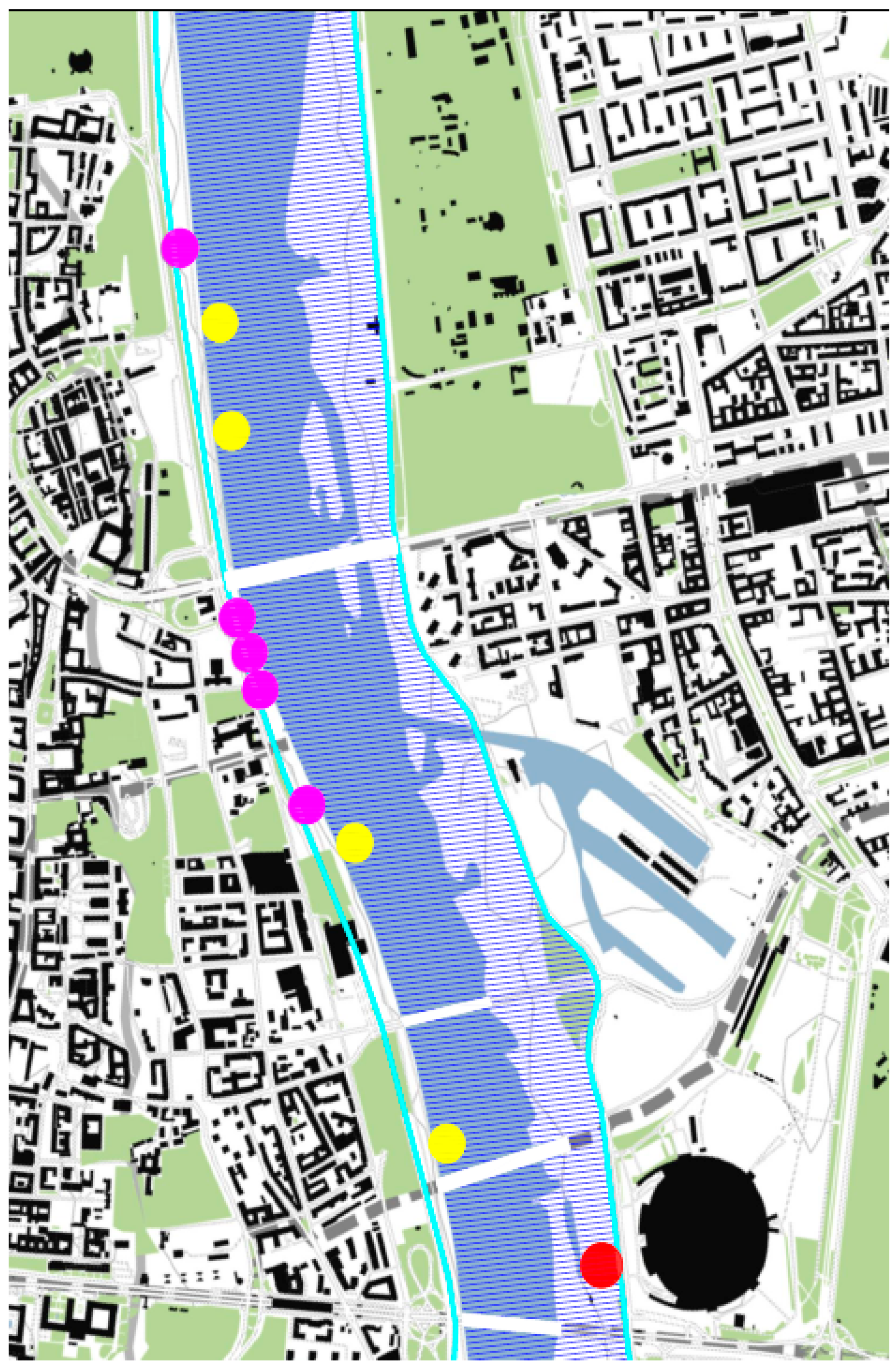



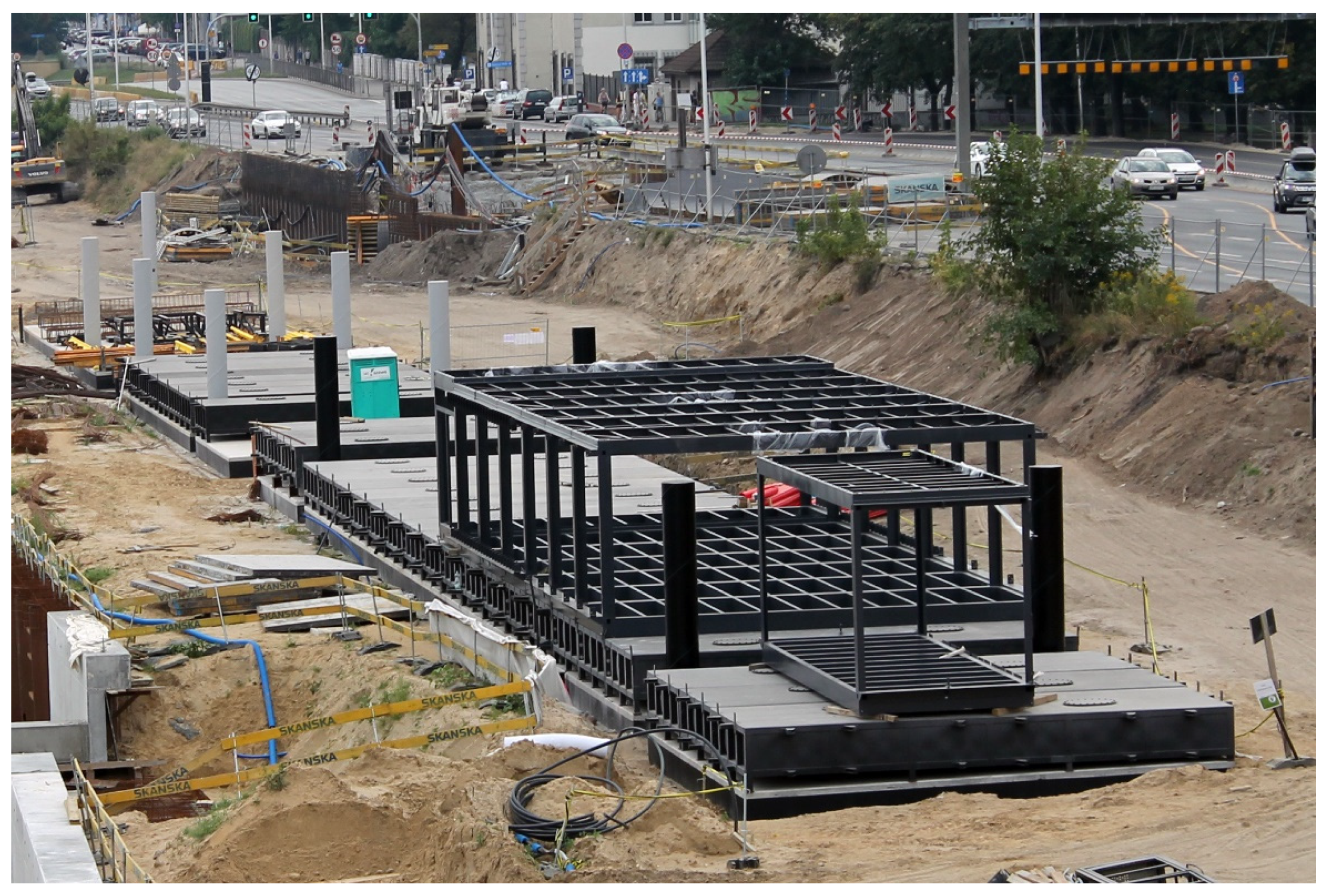
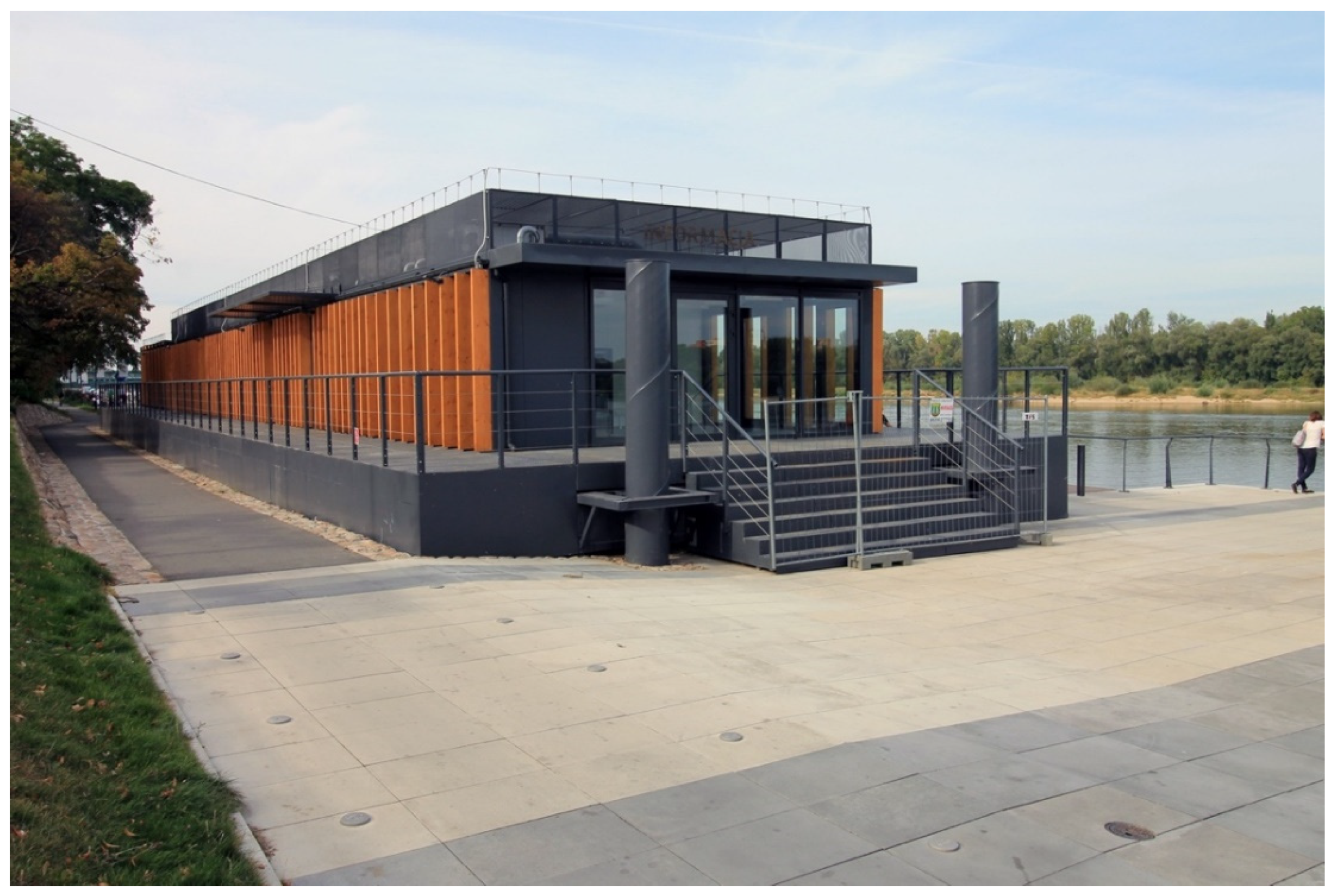

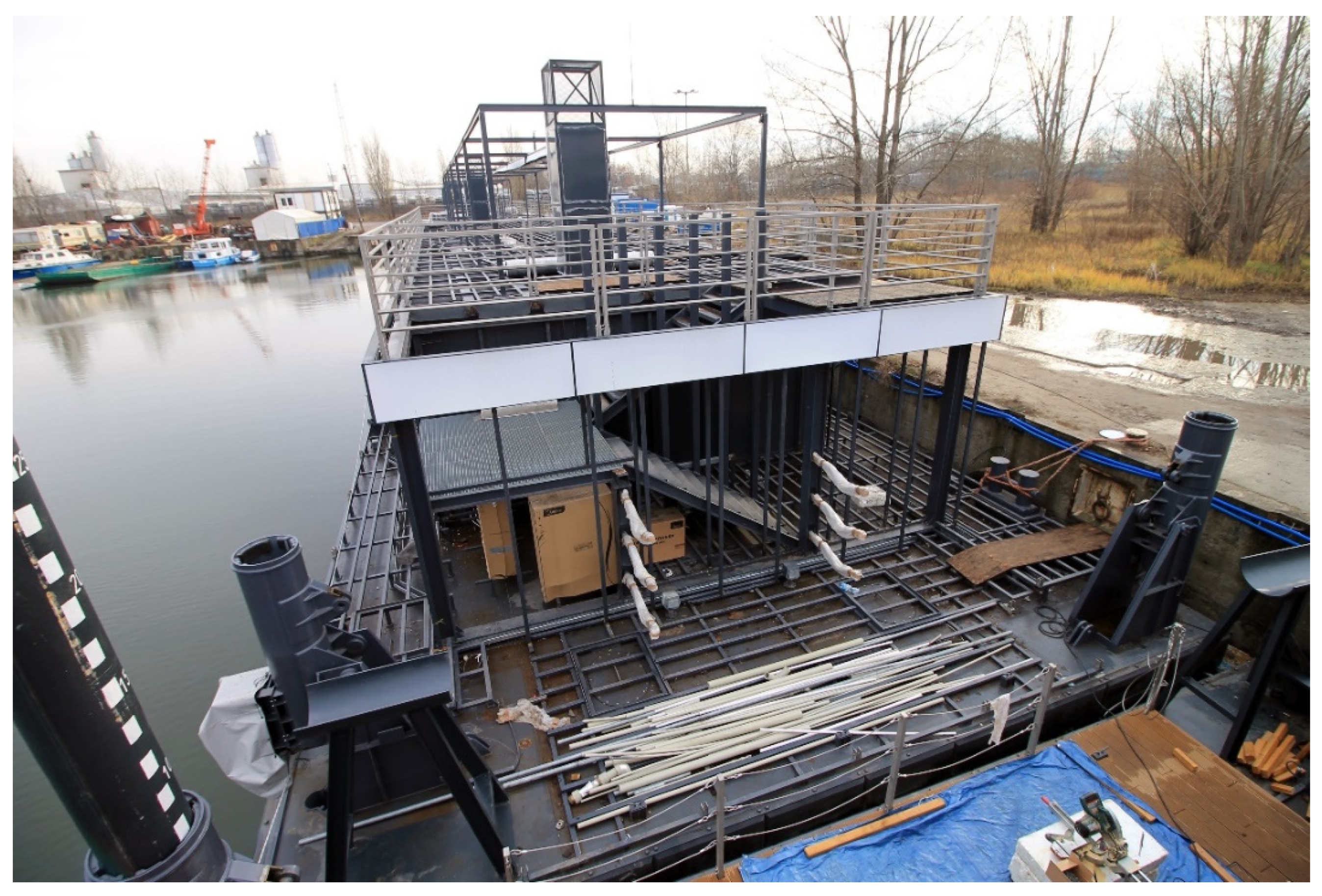
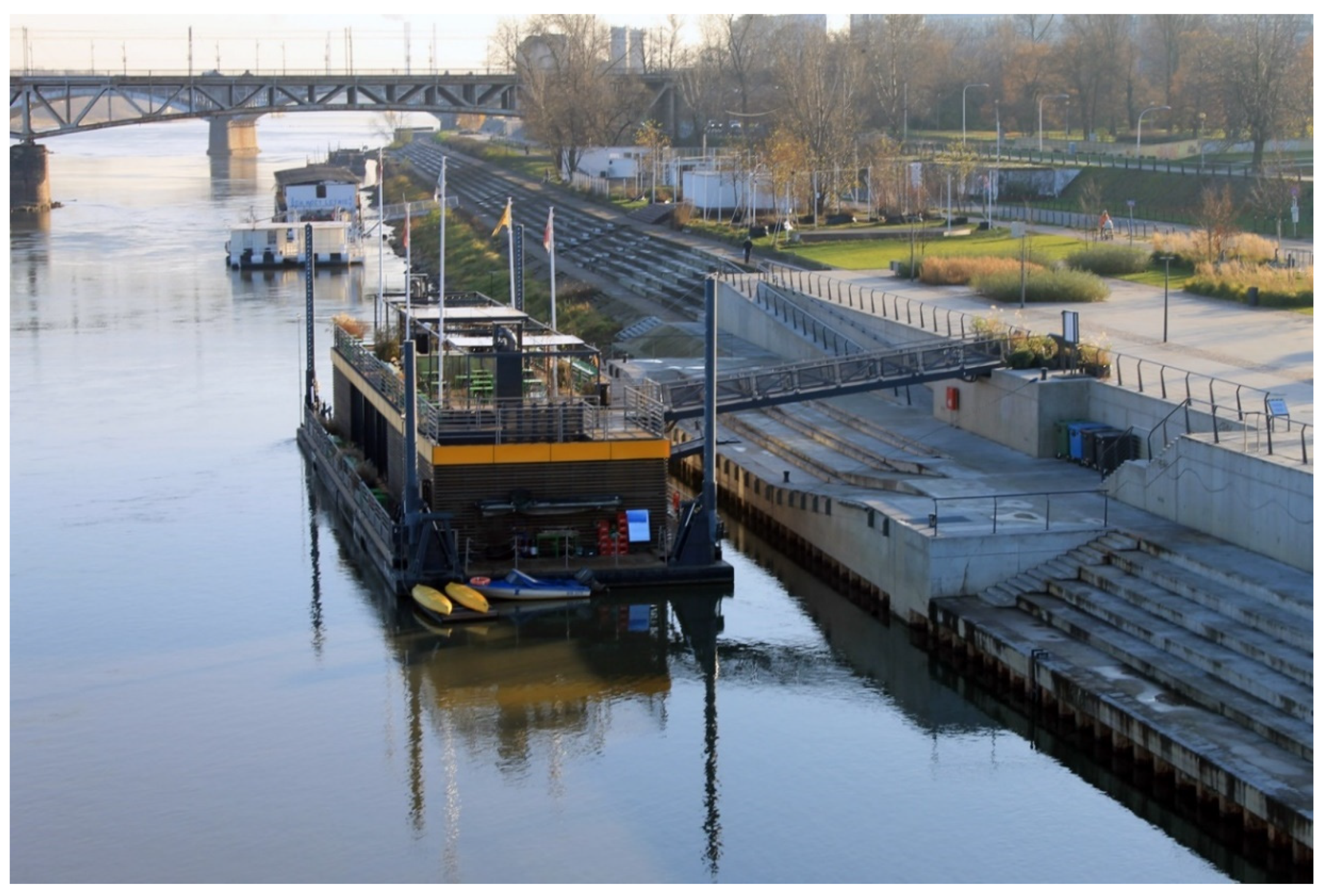
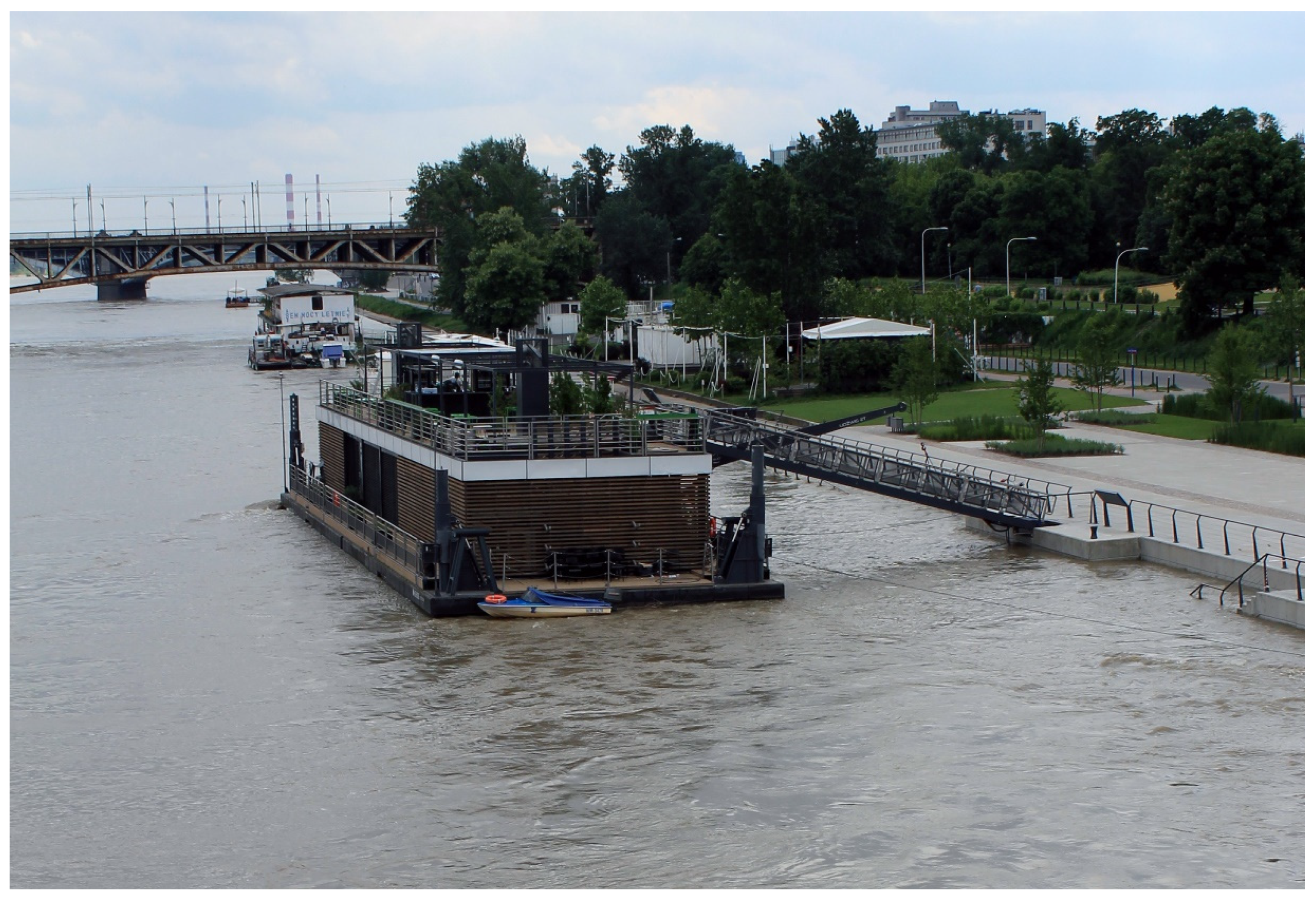
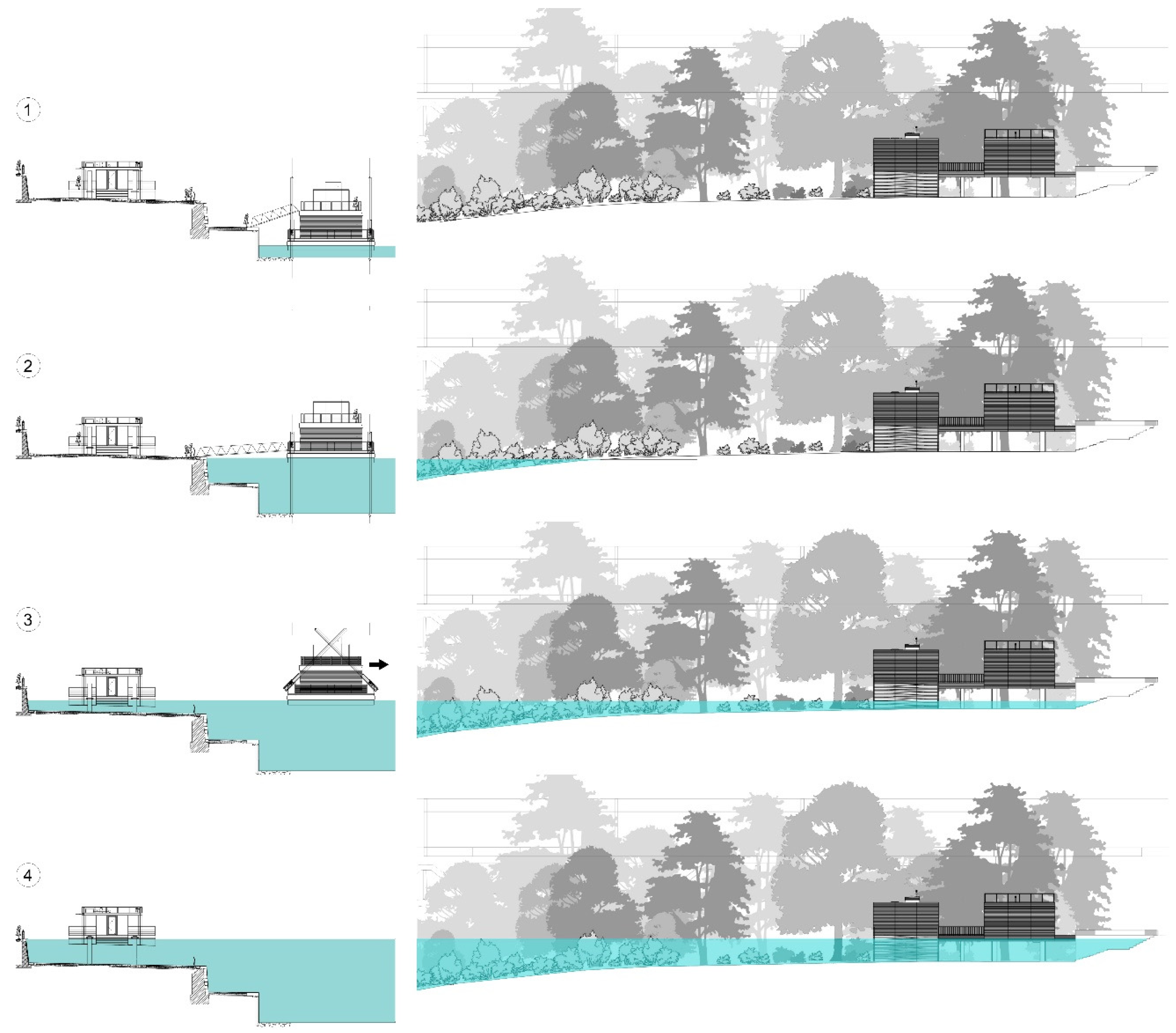
| (Barker and Coutts, 2015) | (Nillesen and Singelenberg, 2011) |
|---|---|
| Elevated building | Dike house |
| Terp house | |
| Pile house | |
| X | Waterside house |
| Dry-proof building | X |
| Wet-proof building | X |
| Can-float (amphibious) building | Amphibious house |
| Floating building | Floating dwelling |
| Project Name | Beach Pavilion | Amphibious Pavilions | Water Tram Terminals |
|---|---|---|---|
| Project date | 2010–2014 | 2009–2017 | 2009–2017 |
| Authors | Ponadto Grupa Projektowa and Pro Arte 11 Studio | RS Architektura Krajobrazu and Artchitecture | BP Szumielewicz i Pawłowski and Navicentrum |
| Type | Pile building | Amphibious building | Floating building |
| Usable area (excl. terraces) | 200 m² | 125–235 m² | 211 m² |
| Units built | 1 | 8 | 4 |
| Number of floors | 1 | 1 | 1 |
| LEGAL FEATURES | |||
| Legal status | Building | Temporary building | Water vessel without propulsion |
| Regulations | Building Code | Building Code | Building Code and Rules for the Classification and Construction of Inland Waterways Vessels |
| RESILIENT FEATURES | |||
| Operational limit (water level) | 910 cm * | 600 cm * | 600 cm * |
| Safety limit (water level) | 910 cm * | About 900 cm * (dolphin pile height) | No limit |
| Floor height level inside the building | 910 cm * | 712 cm * before floating; unknown in the floating mode | 84 cm above water level |
| FUNCTIONAL CONDITIONS | |||
| Access from land | Very good from the escarpment; limited from the beach due to the height difference | Moderate (hampered by the height of the floating base) | Limited (only two gangways with inclination dependent on water level) |
| Visual contact with water | Poor (except for flood events) | Good | Very good |
| Access from water | No access | No access | Very good |
| Redeployability | No | No | Yes |
Publisher’s Note: MDPI stays neutral with regard to jurisdictional claims in published maps and institutional affiliations. |
© 2020 by the authors. Licensee MDPI, Basel, Switzerland. This article is an open access article distributed under the terms and conditions of the Creative Commons Attribution (CC BY) license (http://creativecommons.org/licenses/by/4.0/).
Share and Cite
Piątek, Ł.; Wojnowska-Heciak, M. Multicase Study Comparison of Different Types of Flood-Resilient Buildings (Elevated, Amphibious, and Floating) at the Vistula River in Warsaw, Poland. Sustainability 2020, 12, 9725. https://doi.org/10.3390/su12229725
Piątek Ł, Wojnowska-Heciak M. Multicase Study Comparison of Different Types of Flood-Resilient Buildings (Elevated, Amphibious, and Floating) at the Vistula River in Warsaw, Poland. Sustainability. 2020; 12(22):9725. https://doi.org/10.3390/su12229725
Chicago/Turabian StylePiątek, Łukasz, and Magdalena Wojnowska-Heciak. 2020. "Multicase Study Comparison of Different Types of Flood-Resilient Buildings (Elevated, Amphibious, and Floating) at the Vistula River in Warsaw, Poland" Sustainability 12, no. 22: 9725. https://doi.org/10.3390/su12229725





